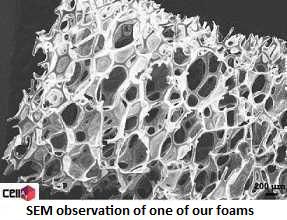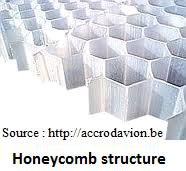Definition and pictures
Cellular materials
A cellular material is defined as a porous material which has an organized structural layout and a ratio matter/air rather low. This structural layout enables to support different kinds of stresses: mechanical, thermal while remaining light.
In natural state, there is this kind of structure in the wood, sponges or bones and teeth.
You can see more pictures if you click here.
Considering that interesting properties (lightness and solidity), Human being had created synthetic cellular materials to meet his needs.
There are two kinds of major structures: honeycomb structure and sponge structure.
Honeycomb structure has regular size and shape cells. It is used in order to reinforce resistance of a part and guarantee a maximal lightness (vacuum rate around 95%). It is especially used to absorb impacts because it has an aptitude to deform itself and to absorb mechanical waves. Honeycomb structure can be produced with aluminium, paper (cardboard) or plastic. We can find this structure in aeronautic industry where they fill empty volumes but also in automobile, yachting and wind-powered applications.

Sponge structure also called foam has opened cells which have different shapes and sizes. Vacuum rate is around 95 %. We find this structure in living beings’ bones and in wood where it enables connection between cells. These properties give an important versatility for its use. It is used in engineering field but also in mechanics, aeronautics, chemistry (porous catalyst) and medical (ceramic implant).
These materials were created industrially rather late. The first one was baking brick for its thermal properties in 3500 BC.


